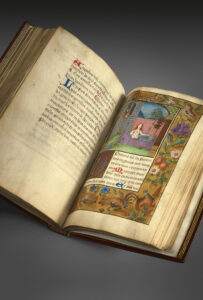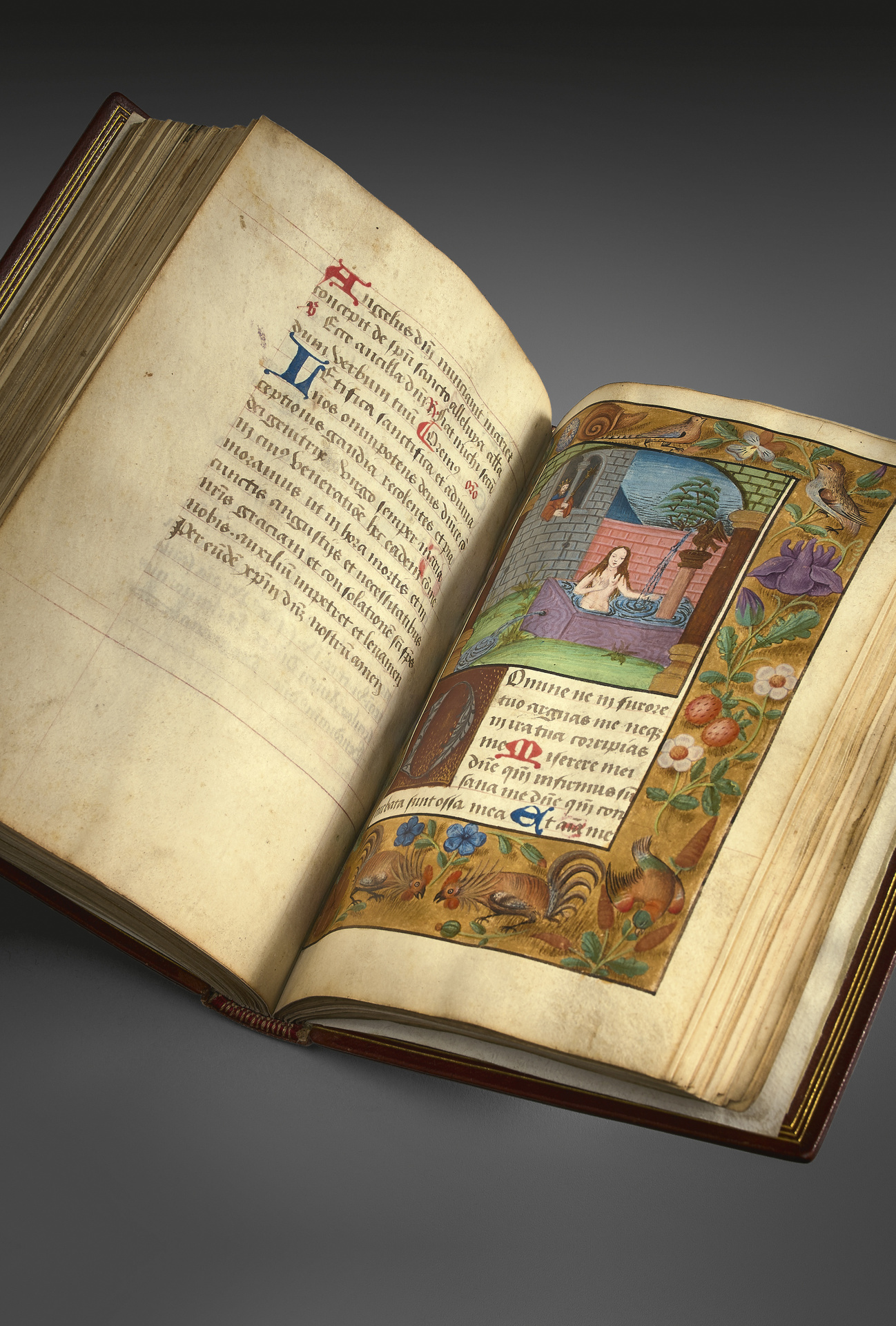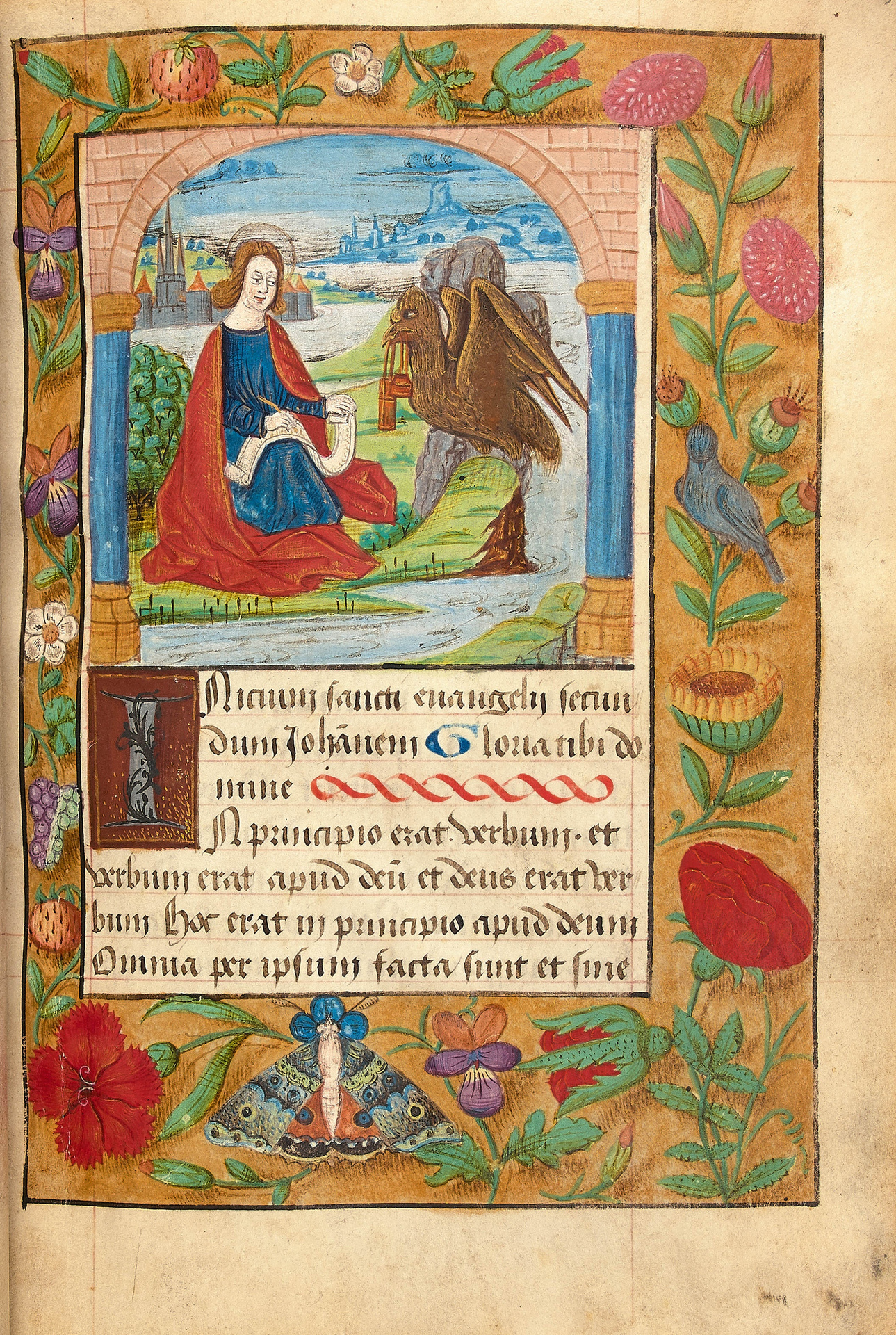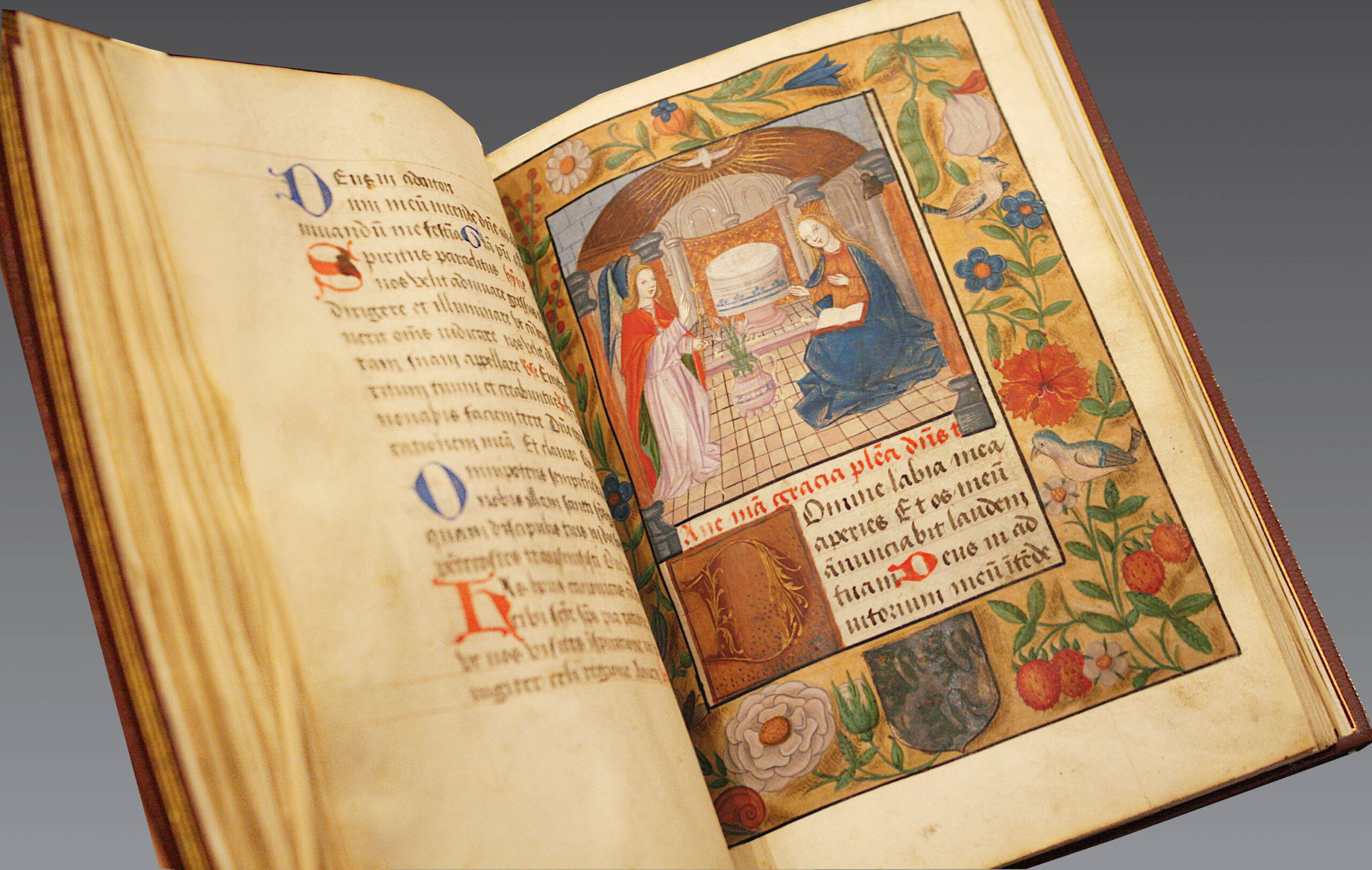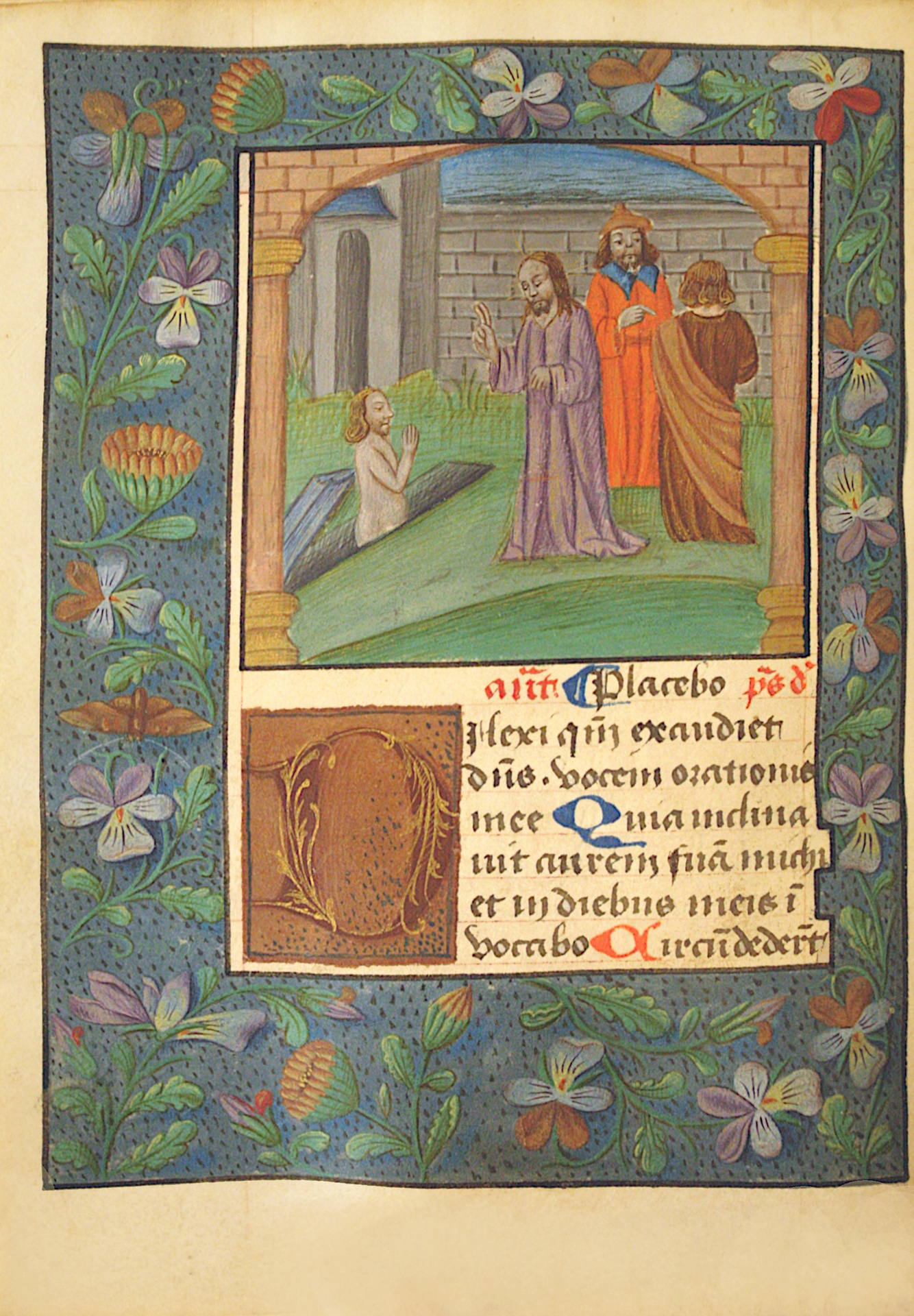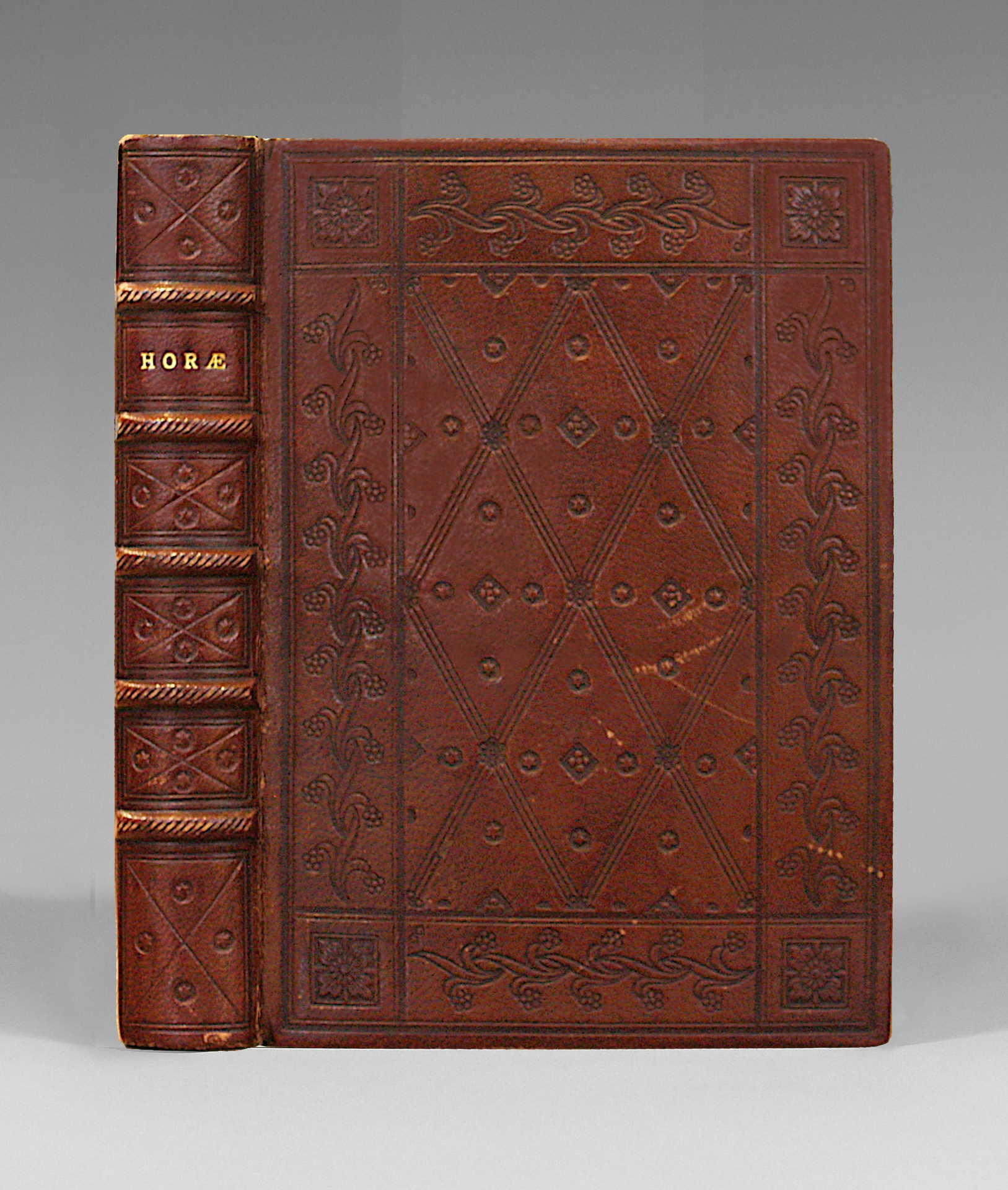France, Abbeville, circa 1480.
12mo of 82 ll. on vellum skin preceded and followed by 1 parchment endleaf. Complete. 19 long lines l. 14 blank. Bastard writing in brown ink, text written in Latin in one column, ruled in violet ink, rubrics in red, initials painted alternately in red or blue, tall initials silver-plated or painted in gold on a brown gold-enhanced background, 2 miniatures in one-quarter of a page, without ornamental borders, 4 tall miniatures in half-page with illuminated ornamental borders. Justification of the text 107 x 73 cm.
Brown leather binding, double framing of blind-stamped fillets on the covers with fleurons in the corners, ribbed blind-stamped spine. Gruel.
180 x 127 mm.
Shimmering illuminated manuscript of high quality, evocative of the Abbeville painting from the 1480s.
Text
L.1 The year March 26th 1724 prayer (prayer added in the 18th century).
Ll. 2-13v Calendar January 22th St. Vinchan in French Picardie dialect, January 30th Saint Auldegonde abbess of Maubeuge, August 11th St. Gérin bishop of Cambrai September 17th St. Lambert bishop of Liège, September 22th St. Meuriche in French Picardie dialect, October 31st St. Quentin martyr from Vermandois, November 3rd St. Hubert bishop of Liège, December 1st St. Eloy bishop of Noyon, December 14th St. Nicaise bishop of Reims.
Ll. 15-15v Pericope of St. John’s Gospel
Ll. 16-18v Hours of the Cross, deficiency of the Crucifixion between Ll. 14v-15
Ll. 20-22v Hours of the Holy Spirit, deficiency of the Pentecost between Ll. 18v-19.
Ll. 23-51v Hours de the Virgin
Ll. 52-62 Psalm of the penitence followed by litanies with Saint Ursule virgin of Cologne.
Ll. 62v-77 Office of the Dead with 3 lectures use of Tournai, Thérouanne or Cambrai.
Ll. 77v-82 Suffrage and oration for father and mother, for one man, for a woman, for parents and friends, for evrybody in general, oration to Saint Anne Saluta est Maria, pious hymn of the blessed Holy Ghost Veni creator, followed by the VII verses of St. Bernard Illumina oculos meos, suffrages of Saint André, sweet oration to the Virgin Mary Ave regina.
L. 82v Erased notes, prayer.
The ornamentation consists of 6 tall illuminated miniatures of beautiful workmanship.
Each of these miniatures is inserted in a superb illuminated ornamental border (decorated with flowers and plants, bestiary, painted in trompe l’œil, painted arms in the lower ornamental border of l. 23).
They present every characteristic of the Abbeville painting from the 1480s:
-L. 15 St-John the Evangelist on the island of Patmos with his symbol. The eagle holds the inkwell in its beak. Frame with blue columns and brick wall. Beautiful landscape.
-L. 23 Annunciation, with arms in the lower margin. The angel surprises the Virgin while reading. Celestial voute resting on the columns of the frame. Flower vase with fleur-de-lis separating the angel Gabriel from the Virgin Mary.
-L. 52 David and Bathsheba bathing (Bathsheba’s face repainted ?). David looks by the window at naked Bathsheba. Frame with columns and brick wall above.
-L. 62v Resurrection of Lazarus in a cemetery. Frame with columns and brick wall.
-L. 79 Sainte Anne Trinitarian: Sainte Anne holds the Virgin and Child in her arms.
-L. 81 Saint André with his Cross.
The ornamental borders, inspired by the Ghent-Bruges school, are very carefully made and represent cockfighting at l. 52, birds and a butterfly at l.14. This type of ornamental borders was imported from Bruges circa 1480-1490 to Amiens by the Master of the prayer book of Dresden (see B. Brinckmann, Die flämische Buchmalerei am Ende des Burgunderrechs : der Meister des Dresdener Gebetbuchs und die Miniaturisten seiner Zeit, Turnhout, 1997).
Hundreds of painted initials brighten up each page of the manuscript.
This charming manuscript at the use of Amiens comes from the Abbeville production from the 1480s.
The Annunciation was executed by a different hand with softer and rounder faces. The rest of the manuscript can be attributed to a second hand which finds its place in the art of French Picardy of the end of the Middle Ages as described by Marc Gil in an unpublished article. The French Picardy art of the 1470-1500s is defined by “the refusal of Fleming illusionism to favor decorative effects above all, a linear simplification of shapes and a geometrization of lines in an emphatic script” (“tLe décor peint de la Chapelle Saint-Eloi (1506):sa place dans l’art picard de la fin du Moyen Ages”). This strong design can be found in the book of Hours of Abbeville Bm. Ms. 16.
There is a thesis available for consultation at the University of Lille by Marie-Laure Legrain (Les manuscrits à peinture en Picardie, autour d’Amiens e d’Abbeville, à la fin du Moyen Age (1480-1520), Lille, 2006).
Some names of active painters in the 1460-1480s have survived: Jean Hachette, Colart du bois, Jean Lefebvre, Robert de Hesdinoel.
Abbeville hosts private mansions of great lords from Burgundy then French lords: the lords of Créquy, of Gamaches, of Gruuthuse, of Rubempré, of Monchy, of Rambures, of Melun and Bonflers. (Marc Gil, « Le contexte de la création à Abbeville et à Amiens (c. 1460-1540) », Saint-Riquier une grande abbaye bénédictine, Paris, 2009, pp. 211-234).
Attractive illuminated manuscript typical of the Abbeville painting from the 1480s.
